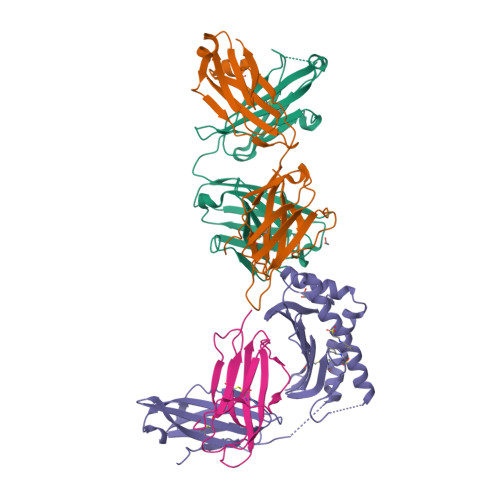
Top ▲

 target has curated data in GtoImmuPdb
target has curated data in GtoImmuPdb
Target id: 2985
Nomenclature: Fc fragment of IgG receptor and transporter
Abbreviated Name: FcRn
Gene and Protein Information  |
||||||
| Species | TM | AA | Chromosomal Location | Gene Symbol | Gene Name | Reference |
| Human | 1 | 365 | 19q13.33 | FCGRT | Fc gamma receptor and transporter | |
| Mouse | 1 | 365 | 7 29.12 cM | Fcgrt | Fc fragment of IgG receptor and transporter | |
| Rat | 1 | 366 | 1q22 | Fcgrt | Fc gamma receptor and transporter | |
Database Links  |
|
| Alphafold | P55899 (Hs), Q61559 (Mm), P13599 (Rn) |
| ChEMBL Target | CHEMBL5966 (Hs) |
| Ensembl Gene | ENSG00000104870 (Hs), ENSMUSG00000003420 (Mm), ENSRNOG00000020583 (Rn) |
| Entrez Gene | 2217 (Hs), 14132 (Mm), 29558 (Rn) |
| Human Protein Atlas | ENSG00000104870 (Hs) |
| KEGG Gene | hsa:2217 (Hs), mmu:14132 (Mm), rno:29558 (Rn) |
| OMIM | 601437 (Hs) |
| Pharos | P55899 (Hs) |
| RefSeq Nucleotide | NM_004107 (Hs), NM_010189 (Mm), NM_033351 (Rn) |
| RefSeq Protein | NP_004098 (Hs), NP_034319 (Mm), NP_203502 (Rn) |
| UniProtKB | P55899 (Hs), Q61559 (Mm), P13599 (Rn) |
| Wikipedia | FCGRT (Hs) |
Selected 3D Structures  |
|||||||||||||

|
|
||||||||||||
Download all structure-activity data for this target as a CSV file 
| Antibodies | |||||||||||||||||||||||||||||||||||||||||||||||||||||||||||||||||||||||||||||||||||||||||||||||||||||||||||||||||||||||||||||||||||||||||||||||||||||||||||||||||||||||||||||||||||
| Key to terms and symbols | Click column headers to sort | ||||||||||||||||||||||||||||||||||||||||||||||||||||||||||||||||||||||||||||||||||||||||||||||||||||||||||||||||||||||||||||||||||||||||||||||||||||||||||||||||||||||||||||||||||
|
|||||||||||||||||||||||||||||||||||||||||||||||||||||||||||||||||||||||||||||||||||||||||||||||||||||||||||||||||||||||||||||||||||||||||||||||||||||||||||||||||||||||||||||||||||
| Antibody Comments | |||||||||||||||||||||||||||||||||||||||||||||||||||||||||||||||||||||||||||||||||||||||||||||||||||||||||||||||||||||||||||||||||||||||||||||||||||||||||||||||||||||||||||||||||||
| The FcRn binding affinity (Kd) of DX-2507 at neutral pH is 2 nM [7]. | |||||||||||||||||||||||||||||||||||||||||||||||||||||||||||||||||||||||||||||||||||||||||||||||||||||||||||||||||||||||||||||||||||||||||||||||||||||||||||||||||||||||||||||||||||
| Immunopharmacology Comments |
| FcRn is important for developing immunity in the fetus and neonate (transporting IgG from mother to fetus and neonate for passive immunity) [3], for the development of adaptive immunity, and for regulating IgG levels (protecting IgG catabolism) in the mature immune system [5]. FcRn expression is upregulated by TNF-α (a proinflammatory cytokine) and downregulated by IFN-γ (an anti-inflammatory cytokine) [6]. In some autoimmune diseases levels of pathogenic IgG autoantibodies are elevated, and their long half-lives and prolonged action are a result of FcRn-mediated protection from degradation. For this reason inhibition of FcRn is viewed as an attractive clinical intervention for IgG-mediated autoimmune diseases [5-6]. FcRn antagonism may also be a strategy applicable to the management of neutralising anti-drug antibodies that can develop in patients receiving biologic/enzyme replacement therapies. Examples of anti-FcRn therapeutics in development pipelines include rozanolixizumab (Phase 2; UCB Pharma), efgartigimod alfa (Phase 2; Argenx), M281 (nipocalimab; Phase 2; Momenta Pharmaceuticals), SYNT001 (Phase 1; Syntimmune) and DX-2507 (preclinical; Shire). |
| Immuno Process Associations | ||
|
||
|
||
|
1. Finch DK, Sleeman MA, Moisan J, Ferraro F, Botterell S, Campbell J, Cochrane D, Cruwys S, England E, Lane S et al.. (2011) Whole-molecule antibody engineering: generation of a high-affinity anti-IL-6 antibody with extended pharmacokinetics. J Mol Biol, 411 (4): 791-807. [PMID:21723291]
2. Finney HM, Lawson ADG, Shaw SG, Smith BJ, Tyson KL, Kevorkian L. (2014) Anti-fcrn antibodies. Patent number: WO2014019727. Assignee: Ucb Pharma S.A.. Priority date: 14/05/2012. Publication date: 06/02/2014.
3. Jones EA, Waldmann TA. (1972) The mechanism of intestinal uptake and transcellular transport of IgG in the neonatal rat. J Clin Invest, 51 (11): 2916-27. [PMID:5080417]
4. Kenniston JA, Taylor BM, Conley GP, Cosic J, Kopacz KJ, Lindberg AP, Comeau SR, Atkins K, Bullen J, TenHoor C et al.. (2017) Structural basis for pH-insensitive inhibition of immunoglobulin G recycling by an anti-neonatal Fc receptor antibody. J Biol Chem, 292 (42): 17449-17460. [PMID:28878017]
5. Kuo TT, Aveson VG. (2011) Neonatal Fc receptor and IgG-based therapeutics. MAbs, 3 (5): 422-30. [PMID:22048693]
6. Kuo TT, Baker K, Yoshida M, Qiao SW, Aveson VG, Lencer WI, Blumberg RS. (2010) Neonatal Fc receptor: from immunity to therapeutics. J Clin Immunol, 30 (6): 777-89. [PMID:20886282]
7. Nixon AE, Chen J, Sexton DJ, Muruganandam A, Bitonti AJ, Dumont J, Viswanathan M, Martik D, Wassaf D, Mezo A et al.. (2015) Fully human monoclonal antibody inhibitors of the neonatal fc receptor reduce circulating IgG in non-human primates. Front Immunol, 6: 176. [PMID:25954273]
8. Ulrichts P, Cousin T, Dreier T, de Haard H, Leupin N. (2016) Argx-113, a Novel Fc-Based Approach for Antibody-Induced Pathologies Such As Primary Immune Thrombocytopenia. Blood, 128: 4919.
Immunoglobulin C1-set domain-containing proteins: Fc fragment of IgG receptor and transporter. Last modified on 02/06/2021. Accessed on 23/04/2024. IUPHAR/BPS Guide to PHARMACOLOGY, https://www.guidetopharmacology.org/GRAC/ObjectDisplayForward?objectId=2985.